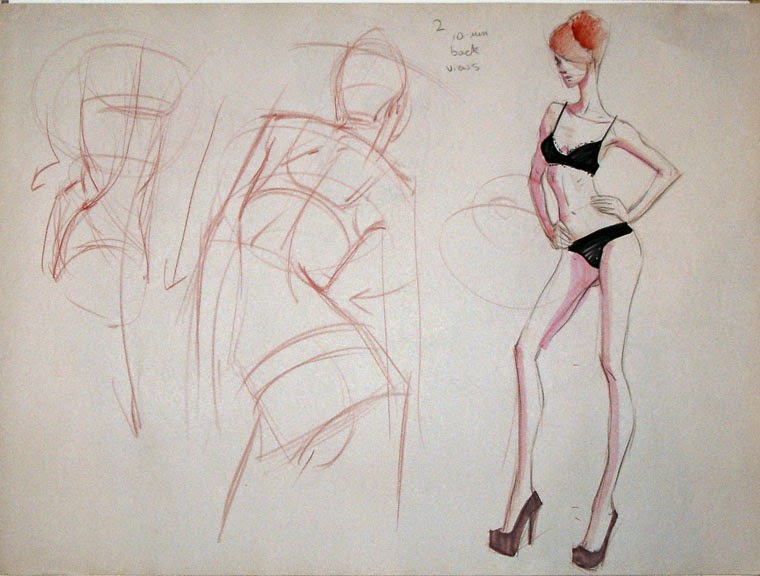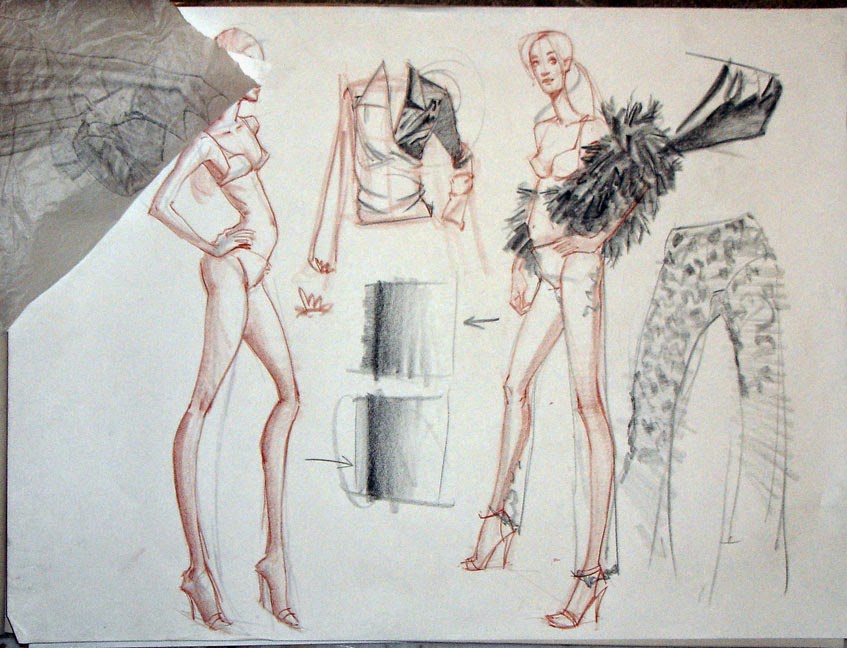Warm-ups. This time we started with Seven 3-minute poses:
Note: Flat shoes the whole class, including warm-ups.
I immediately went into flat feet demos. I like to use a triangle to lay in flat feet, and build my shapes from that.
We then completed One 20-minute drawing, followed by Three 15-minute drawings.
Student work:
The above page is a great example of a finished page from class.
Also, you have the option of flipping the paper vertically to draw big. The measurement system is a bit tricky here so you need to watch that. The measurements should be: 3 heads from the top of the head to the waistline; 3 heads from the waist to the knee; 3 heads from the knee to the ankle/bottom of the foot. If you've got heels on the figure it can turn into a 9.5 head figure. There is approximately one head length from the waist to the crotch line.
Otis Fashion, Model Drawing 3
Friday, October 31, 2014
Model Drawing 3, Week 9
We began by warming up with Twenty 1-minute poses.
Back view demos followed by Two 10-minute back views. Note the clean shadow shapes you can achieve for flesh tones using markers.
Head demos. Always work big to small, and pay attention to the simple shapes you construct. Following the demo we did One 20-minute figure.
Large shapes also work for hands and feet. These are all the photos from week 9, but there were no absences so if you're missing work, ask someone from class what other drawings we did.
Saturday, October 11, 2014
Monday, October 6, 2014
Model Drawing 3, Week 6
Shape warm-ups:
Three 3-minute pastel shape drawings with no lay-in; followed by three 4-minute silhouette/contour drawing with quick gesture laid in lightly. Shoulder and hip angles help.
After the silhouette drawings, we completed three 7-minute head studies.
We then went straight into problem solving. Fabric trains. The model turned 360 degrees on the platform and we completed three 5-minute train studies.
Pull study and mini-lecture.
Handling multiple layers of transparency with markers. Figure first, then 1st layer of transparent fabric, then details of the fabric, then 2nd layer of transparency, etc. Two 5-minute studies of model in lace pants, long robe, and bikini top. We created a train/puddle with the robe. Multiple transparencies also work with colored pencils.
We ended the day with three 5-minute head studies as requested by the class.
Three 3-minute pastel shape drawings with no lay-in; followed by three 4-minute silhouette/contour drawing with quick gesture laid in lightly. Shoulder and hip angles help.
After the silhouette drawings, we completed three 7-minute head studies.
We then went straight into problem solving. Fabric trains. The model turned 360 degrees on the platform and we completed three 5-minute train studies.
Pull study and mini-lecture.
Handling multiple layers of transparency with markers. Figure first, then 1st layer of transparent fabric, then details of the fabric, then 2nd layer of transparency, etc. Two 5-minute studies of model in lace pants, long robe, and bikini top. We created a train/puddle with the robe. Multiple transparencies also work with colored pencils.
We ended the day with three 5-minute head studies as requested by the class.
Monday, September 29, 2014
Model Drawing 3, Week 5
Warm-up gesture drawings include: five 2-minute bikini figures, three 3-minute figures in a robe, and five 3-minute figures in a cape.
We also drew one quick figure with kimono sleeves:
Student work:
We then spoke about different topics, specifically puddles, cowls, and feathers. I drew numerous demos of puddles and lectured about using the perspective of the model stand to assist in drawing the puddle of any particular garment. It helps to have an idea of a horizon line and 2 vanishing points to make puddles feel as though they are laying directly onto the ground plane.
We then moved on to cowls. Different materials produce different cowls. Stiffer materials or materials with a lot of body produce larger and fewer cowls, whilst slinkier or thinner materials produce a greater number of smaller cowls.
Cowls tend to repeat a little "cup" shape over and over; these little "cup" shapes have 3 defining planes: the bottom of the "cup", the lip, and the inside. These cups tend to spoon each other, creating a cowl.
We drew two 7-minute cowl studies with scraps of charmeuse and chiffon. I drew profile views, in which the "cup" shapes become more apparent.
We ended class with different strategies for laying in and drawing feather boas. I suggested using a variety of pencil widths and edges to create the illusion of different textures, as well as laying in "spaghetti noodles" to plan not only the location of the boa, but the desired width - and therefore length- of the feathers.
Sunday, September 21, 2014
Model Drawing 3, Week 4
Warm-ups:
Five 2-minute gestures, followed by five 2-minute, two-handed contour drawings.
We moved on to four 3-minute gestures with a cape, followed by one 7-minute rendering of a satiny bathing suit.
We then completed three 10-minute figures in a bathing suit, finished enough to place tracing paper over.
Student work:
I completed one garment on tracing paper (a satin nightgown with satiny shirt over it), followed by a demonstration of quickly indicating satin. Note the strong highlights, core shadow, and reflected light that characterizes a satin finish. Lace can quickly be laid in with "squiggles" although if more time is available, I prefer a more finished rendering as according to the illustration teacher.
The last figure wore a feather boa, just without the proper feathers to make it a real feather boa:
Student work:
Final page:
Five 2-minute gestures, followed by five 2-minute, two-handed contour drawings.
We moved on to four 3-minute gestures with a cape, followed by one 7-minute rendering of a satiny bathing suit.
We then completed three 10-minute figures in a bathing suit, finished enough to place tracing paper over.
Student work:
I completed one garment on tracing paper (a satin nightgown with satiny shirt over it), followed by a demonstration of quickly indicating satin. Note the strong highlights, core shadow, and reflected light that characterizes a satin finish. Lace can quickly be laid in with "squiggles" although if more time is available, I prefer a more finished rendering as according to the illustration teacher.
The last figure wore a feather boa, just without the proper feathers to make it a real feather boa:
Student work:
Final page:
Friday, September 12, 2014
Model Drawing 3, Week 3
We began with our gesture warm-ups, completing TEN 1-MINUTE poses, followed by FIVE 2-MINUTE poses. I prefer for these to be done with a permanent media every once in a while so as to improve line quality.
We then drew THREE 3-MINUTE figures - as exemplified on the left - utilizing 2 pastels (one light, one dark) to lay in shadow shapes and high light shapes. This results in a drawing with 3 values: a midtone, a shadow tone, and a high light tone. In this way we can quickly and gesturally convey a dimensional figure. This exercise can be completed in marker, but pastel is faster and easier.
Student Work:
We then completed a TEN MINUTE drawing (drawing on the right) using the above techniques: A light gesture drawing lay-in, a contour/continuous line drawing to flesh out the figure and add structural elements (face, hands, feet, anatomy), followed by the shadow/highlight tone lay-in, and shape/color block in for the bathing suit.
Student work:
Student completed the above study in pastel.
Student completed the above study in marker.
We then completed a TEN MINUTE multi-tiered drawing, beginning with a figure in a bikini. Again, the sequence of steps was as follows: 1. Gesture drawing using fashion proportions; 2. Contour line drawing to flesh the figure out; 3. Rendering of the bathing suit to capture the reflective properties of the material. I gave the option of rendering it as charmeuse using the rendering technique taught by the illustration/design instructor or rendering it from observation.
On tracing paper we drew and rendered a FOUR MINUTE silk nighty, again this was to practice capturing the reflective properties of silk.
We then drew another FOUR MINUTE garment study over the figure, this time using a transparent robe.
We ended class with a class critique.
Subscribe to:
Comments (Atom)





















































